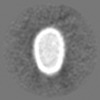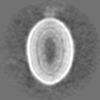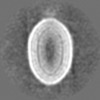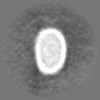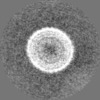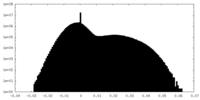+ Open data
Open data
- Basic information
Basic information
| Entry |  | ||||||||||||
|---|---|---|---|---|---|---|---|---|---|---|---|---|---|
| Title | C1 reconstruction of Tanay virus particle | ||||||||||||
 Map data Map data | C1 reconstruction of TANAV particle | ||||||||||||
 Sample Sample |
| ||||||||||||
 Keywords Keywords | Mosquito virus / Negevirus / Envelope / VIRUS | ||||||||||||
| Biological species |  Tanay virus Tanay virus | ||||||||||||
| Method | single particle reconstruction / cryo EM / Resolution: 23.6 Å | ||||||||||||
 Authors Authors | Okamoto K / Song C / Miyazaki N / Murata K | ||||||||||||
| Funding support |  Sweden, Sweden,  Japan, 3 items Japan, 3 items
| ||||||||||||
 Citation Citation |  Journal: J Gen Virol / Year: 2023 Journal: J Gen Virol / Year: 2023Title: Structure and its transformation of elliptical nege-like virus Tanay virus. Authors: Kenta Okamoto / Chihong Song / Han Wang / Miako Sakaguchi / Christina Chalkiadaki / Naoyuki Miyazaki / Takeshi Nabeshima / Kouichi Morita / Shingo Inoue / Kazuyoshi Murata /    Abstract: Negeviruses that infect insects are recently identified virus species that are phylogenetically related to several plant viruses. They exhibit a unique virion structure, an elliptical core with a ...Negeviruses that infect insects are recently identified virus species that are phylogenetically related to several plant viruses. They exhibit a unique virion structure, an elliptical core with a short projection. Negeviruses encode two structural proteins, a glycoprotein that forms a short projection, and an envelope protein that forms an elliptical core. The glycoprotein has been reported only in the negeviruses' genes, and not in phylogenetically related plant viruses' genes. In this report, we first describe the three-dimensional electron cryo-microscopy (cryo-EM) structure of Tanay virus (TANAV), one of the nege-like viruses. TANAV particle demonstrates a periodical envelope structure consisting of three layers surrounding the centred viral RNA. The elliptical core dynamically changes its shape under acidic and even low detergent conditions to form bullet-like or tubular shapes. The further cryo-EM studies on these transformed TANAV particles reveal their overall structural rearrangement. These findings suggest putative geometries of TANAV and its transformation in the life cycle, and the potential importance of the short projection for enabling cell entry to the insect hosts. | ||||||||||||
| History |
|
- Structure visualization
Structure visualization
| Supplemental images |
|---|
- Downloads & links
Downloads & links
-EMDB archive
| Map data |  emd_16440.map.gz emd_16440.map.gz | 222.1 MB |  EMDB map data format EMDB map data format | |
|---|---|---|---|---|
| Header (meta data) |  emd-16440-v30.xml emd-16440-v30.xml emd-16440.xml emd-16440.xml | 12.3 KB 12.3 KB | Display Display |  EMDB header EMDB header |
| Images |  emd_16440.png emd_16440.png | 56.5 KB | ||
| Filedesc metadata |  emd-16440.cif.gz emd-16440.cif.gz | 3.9 KB | ||
| Others |  emd_16440_half_map_1.map.gz emd_16440_half_map_1.map.gz emd_16440_half_map_2.map.gz emd_16440_half_map_2.map.gz | 193.6 MB 193.8 MB | ||
| Archive directory |  http://ftp.pdbj.org/pub/emdb/structures/EMD-16440 http://ftp.pdbj.org/pub/emdb/structures/EMD-16440 ftp://ftp.pdbj.org/pub/emdb/structures/EMD-16440 ftp://ftp.pdbj.org/pub/emdb/structures/EMD-16440 | HTTPS FTP |
-Validation report
| Summary document |  emd_16440_validation.pdf.gz emd_16440_validation.pdf.gz | 858.9 KB | Display |  EMDB validaton report EMDB validaton report |
|---|---|---|---|---|
| Full document |  emd_16440_full_validation.pdf.gz emd_16440_full_validation.pdf.gz | 858.5 KB | Display | |
| Data in XML |  emd_16440_validation.xml.gz emd_16440_validation.xml.gz | 15.7 KB | Display | |
| Data in CIF |  emd_16440_validation.cif.gz emd_16440_validation.cif.gz | 18.6 KB | Display | |
| Arichive directory |  https://ftp.pdbj.org/pub/emdb/validation_reports/EMD-16440 https://ftp.pdbj.org/pub/emdb/validation_reports/EMD-16440 ftp://ftp.pdbj.org/pub/emdb/validation_reports/EMD-16440 ftp://ftp.pdbj.org/pub/emdb/validation_reports/EMD-16440 | HTTPS FTP |
- Links
Links
| EMDB pages |  EMDB (EBI/PDBe) / EMDB (EBI/PDBe) /  EMDataResource EMDataResource |
|---|
- Map
Map
| File |  Download / File: emd_16440.map.gz / Format: CCP4 / Size: 244.1 MB / Type: IMAGE STORED AS FLOATING POINT NUMBER (4 BYTES) Download / File: emd_16440.map.gz / Format: CCP4 / Size: 244.1 MB / Type: IMAGE STORED AS FLOATING POINT NUMBER (4 BYTES) | ||||||||||||||||||||||||||||||||||||
|---|---|---|---|---|---|---|---|---|---|---|---|---|---|---|---|---|---|---|---|---|---|---|---|---|---|---|---|---|---|---|---|---|---|---|---|---|---|
| Annotation | C1 reconstruction of TANAV particle | ||||||||||||||||||||||||||||||||||||
| Projections & slices | Image control
Images are generated by Spider. | ||||||||||||||||||||||||||||||||||||
| Voxel size | X=Y=Z: 1.992 Å | ||||||||||||||||||||||||||||||||||||
| Density |
| ||||||||||||||||||||||||||||||||||||
| Symmetry | Space group: 1 | ||||||||||||||||||||||||||||||||||||
| Details | EMDB XML:
|
-Supplemental data
-Half map: Half-map1
| File | emd_16440_half_map_1.map | ||||||||||||
|---|---|---|---|---|---|---|---|---|---|---|---|---|---|
| Annotation | Half-map1 | ||||||||||||
| Projections & Slices |
| ||||||||||||
| Density Histograms |
-Half map: Half-map2
| File | emd_16440_half_map_2.map | ||||||||||||
|---|---|---|---|---|---|---|---|---|---|---|---|---|---|
| Annotation | Half-map2 | ||||||||||||
| Projections & Slices |
| ||||||||||||
| Density Histograms |
- Sample components
Sample components
-Entire : Tanay virus
| Entire | Name:  Tanay virus Tanay virus |
|---|---|
| Components |
|
-Supramolecule #1: Tanay virus
| Supramolecule | Name: Tanay virus / type: virus / ID: 1 / Parent: 0 / NCBI-ID: 1489714 / Sci species name: Tanay virus / Virus type: VIRION / Virus isolate: STRAIN / Virus enveloped: Yes / Virus empty: No |
|---|
-Experimental details
-Structure determination
| Method | cryo EM |
|---|---|
 Processing Processing | single particle reconstruction |
| Aggregation state | particle |
- Sample preparation
Sample preparation
| Buffer | pH: 8 |
|---|---|
| Vitrification | Cryogen name: ETHANE |
- Electron microscopy
Electron microscopy
| Microscope | JEOL 2200FS |
|---|---|
| Image recording | Film or detector model: DIRECT ELECTRON DE-20 (5k x 3k) / Average electron dose: 20.0 e/Å2 |
| Electron beam | Acceleration voltage: 200 kV / Electron source:  FIELD EMISSION GUN FIELD EMISSION GUN |
| Electron optics | Illumination mode: FLOOD BEAM / Imaging mode: BRIGHT FIELD / Nominal defocus max: 5.0 µm / Nominal defocus min: 0.5 µm |
- Image processing
Image processing
| Startup model | Type of model: INSILICO MODEL |
|---|---|
| Final reconstruction | Resolution.type: BY AUTHOR / Resolution: 23.6 Å / Resolution method: FSC 0.143 CUT-OFF / Number images used: 10282 |
| Initial angle assignment | Type: MAXIMUM LIKELIHOOD |
| Final angle assignment | Type: MAXIMUM LIKELIHOOD |
 Movie
Movie Controller
Controller



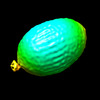
 Z (Sec.)
Z (Sec.) Y (Row.)
Y (Row.) X (Col.)
X (Col.)









